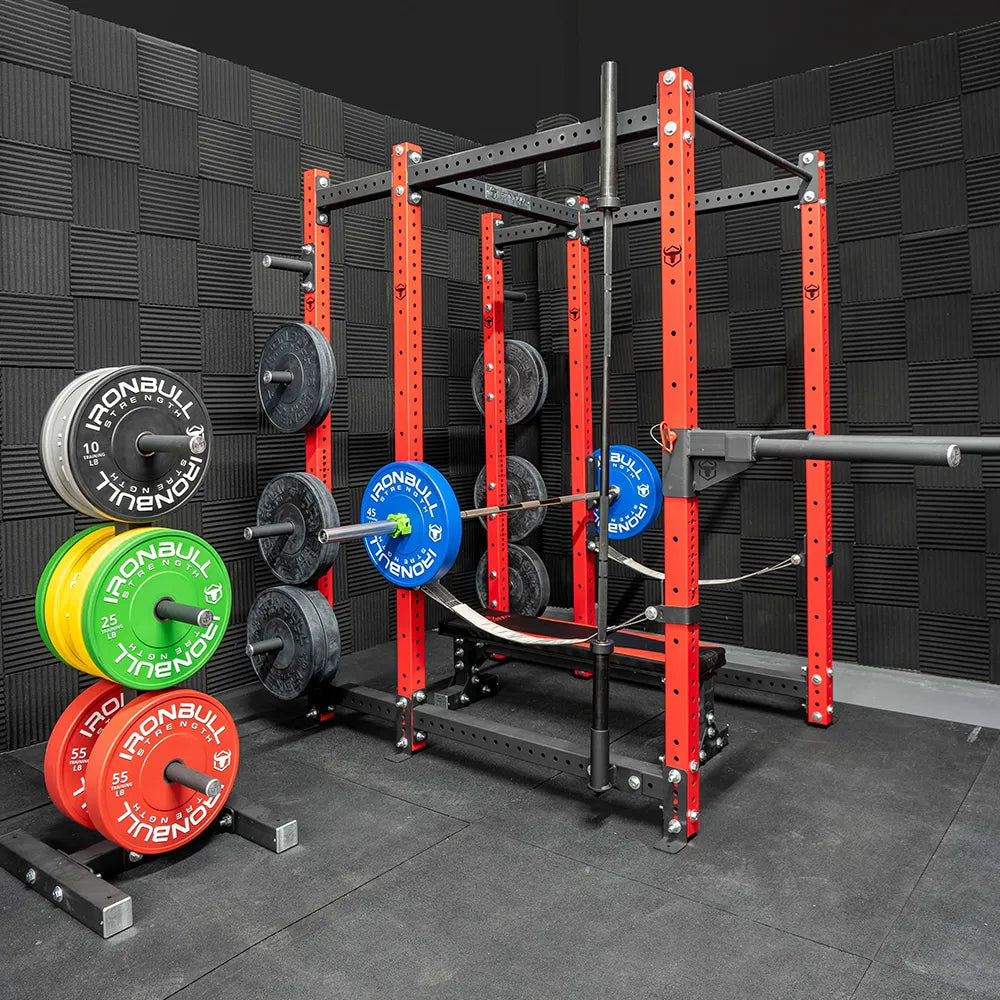Quelle est la meilleure forme pour un rack à squat ?

Configuration ergonomique du Squat Rack
Lors de l'installation de votre rack à squat , la première chose à déterminer est sa hauteur. La barre doit être à hauteur d'épaule lorsque vous la retirez.
De cette façon, vous n'aurez pas à vous étirer ni à forcer pour commencer. Considérez cela comme une préparation pour une performance fluide.
Parlons maintenant des barres de sécurité. Placez-les juste en dessous de votre profondeur de squat la plus basse.
Ainsi, si jamais vous sentez que vous n'arrivez pas à terminer un mouvement, les barres de sécurité sont là pour la retenir. C'est comme un filet de sécurité pendant un numéro de trapèze, sauf que vous êtes le trapéziste et la barre votre partenaire.
La stabilité est essentielle. Assurez-vous que votre rack à squats soit posé sur une surface plane. Toute oscillation ou déséquilibre peut déstabiliser votre mouvement et entraîner des blessures. Une base solide est essentielle pour construire quoi que ce soit, et les squats ne font pas exception.
Position appropriée pour les squats
Maintenant, préparons votre posture. Tenez-vous debout, les pieds écartés à la largeur des épaules. Cela vous donne une base solide pour travailler, un peu comme planter vos pieds avant de frapper une piñata.
Vos orteils doivent pointer légèrement vers l'extérieur, à un angle compris entre 15 et 30 degrés. Cela permet un suivi naturel du genou pendant le squat, vous évitant ainsi toute torsion ou rotation gênante.
En ce qui concerne la répartition du poids, assurez-vous qu'il soit équilibré sur l'ensemble de votre pied. Ne mettez pas toute la pression sur vos talons ou vos orteils. C'est comme se tenir debout sur une planche d'équilibre : la stabilité vient d'une répartition uniforme de la charge.
Pour maintenir votre ceinture abdominale stable, vous pouvez envisager d'utiliser des ceintures de musculation . Elles vous aideront à maintenir une posture stable tout au long de l'exercice.
Placement correct de la barre à l'arrière
Parlons maintenant de l'emplacement de la barre sur votre dos. Pour le haut du dos, placez-la sur vos trapèzes. Évitez de la placer directement sur votre cou, car cela pourrait provoquer des tensions et une gêne.
Si vous optez pour un squat avec barre basse, positionnez la barre légèrement plus bas sur vos deltoïdes postérieurs. Cela permet une plus grande sollicitation des hanches, un peu comme changer de vitesse en voiture pour gagner en puissance.
Votre prise en main est également importante. Tenez fermement la barre, les mains légèrement plus écartées que la largeur des épaules. Cela vous permet de garder le contrôle pendant le squat et d'éviter tout vacillement inattendu.
L'ajout de coudières peut améliorer la stabilité et le confort des articulations lors du placement de la barre et des squats. Elles offrent un véritable câlin aux coudes.
Technique de démontage pour la sécurité du squat
Au moment de retirer la barre, placez-vous près d'elle. Placez-vous directement sous la barre, en la gardant près de votre centre de gravité. Cela facilite le contrôle, un peu comme si vous teniez une valise près de votre corps.
Utilisez vos jambes pour retirer la barre. Tendez vos jambes plutôt que votre dos. Cela minimise la tension sur votre colonne vertébrale et donne l'impression de se lever d'une chaise.
Une fois la barre retirée du support, maintenez-la stable en reculant. Cela lui permet de rester stable sur vos épaules et de vous sentir comme un funambule avec un sens de l'équilibre parfait.
Pensez à intégrer des supports de poids pour accéder facilement aux disques et faciliter l'installation des barres avant les squats. C'est comme avoir une boîte à outils bien organisée avant de commencer un projet.
Mouvement d'accroupissement approprié
Au début du squat, gardez la poitrine bombée et le tronc contracté. Cela permet de maintenir une bonne posture tout au long du mouvement, comme garder la tête haute en marchant en ligne droite.
Commencez le squat en poussant vos hanches vers l'arrière, sans plier les genoux au préalable. Cela protège vos articulations et donne l'impression de s'asseoir sur une chaise.
Descendez jusqu'à ce que vos cuisses soient parallèles au sol, ou aussi loin que votre souplesse le permet, tout en conservant la posture. Imaginez une descente sur un toboggan : ni trop vite, ni trop lentement.
En vous relevant, poussez sur vos talons. Cela permet de transmettre la puissance de vos jambes, ce qui vous donne l'impression de pousser sur le sol pour sauter.
Pour un soutien supplémentaire et réduire la tension sur vos genoux, vous pouvez utiliser des genouillères . C'est comme enfiler une paire de chaussettes confortables avant de courir.
Repositionnement sécurisé de la barre
Une fois votre squat terminé, avancez sur le rack. Assurez-vous que la barre touche les montants du rack. C'est comme garer une voiture : placez-la au bon endroit avant de couper le moteur.
Abaissez la barre sur les crochets avec précaution. Évitez de la laisser tomber ou de la précipiter pour éviter les blessures. Imaginez que vous déposez délicatement un vase délicat sur une étagère.
Restez en contrôle jusqu'à ce que la barre soit bien fixée aux crochets du support. Cela vous permettra de vous assurer que tout est en sécurité avant de vous éloigner, comme vérifier une porte verrouillée avant de quitter la maison.
Améliorez votre entraînement avec des bancs de musculation . Ils complètent le rack à squat pour une plus grande variété d'exercices, un peu comme ajouter un nouvel outil à votre arsenal de fitness.


